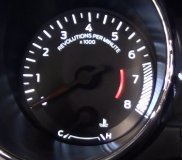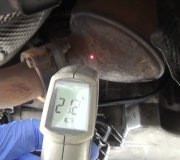Yes,you're correct, if it was an air leak (vacuum leak) it would cause the fuel trims to come down towards zero at WOT, along with being in open loop, manifold vacuum would be closer to atmospheric pressure and the leak wouldn't effect fuel trims like they are, so yes it appears to be an actual lean condition. Your MAF readings suggest it's okay. They were a little better on the first pull, but still within spec. The AF ratio of 1.0 is stoichiometric (14.7/1) so 1.23 is an actual lean condition reading as well, you might be looking at clogged up, restricted injectors here.
You've really gone through almost everything, if an injector balance test shows different flow rates between the 4 of them, then you'll know there's at least an issue there. Really they should all flow exactly the same, have you done an injector balance test with a fuel gauge on the rail before? Where you get fuel pressure up to its max, then pulse each injector one at a time and watch for how much the fuel pressure drops on each injector. It requires an injector pulse tool or your Autel might be able to do it under special functions. You just need to re-prime the fuel pump each time, and once you run through all 4 injectors start the car to get the fuel out of all the cylinders, then you can re-run it again if needed. But if you find the fuel pressure drop is even a few psi off from other injectors, you know there's an issue there as well.
I think the ECM is at its complete limit for compensation, it just can't go any more than that percentage, it's a substituted value but extremely high, I think service info stated a 35% (or +25%) was the limit on positive fuel trims.
You could also graph the rear oxygen sensor voltage, and it should go full rich (high voltage) at a WOT run, and then it should have an injector cutoff when decel, my guess is you are going to see the rear 02 go lean instead. The MAF readings should be lower if this was a restricted exhaust, because the engine would not be able to take in more air if it can't let exhaust out.
As for the ECM being the problem, I would definitely rule out the injectors and back pressure first, making a call on an module is always a last resort and a difficult call as well. Because if a new ECM makes no difference you're back to square one. I'm surprised it's not setting other codes.
Whats your injector on time (pulse width) at idle? I'd think 2.5ms to 4ms for an injector pulse at idle should be about right and WOT I would guess 15ms +. Thats another way you could see if the ECM is really compensating for this condition. Honestly it's nice to be able to have someone who understands these terms, having to explain all this can take weeks sometimes.
One last thing I've been doing in past few years is going through the Mode 6 data. If there's something that is close to setting a code but not there yet, it will show in the mode 6 data list, Autel shows a good list of it all. Just look for "OK" or "Failed" in the test results. And even the number is gives for the test result can give you a clue as to what monitor is close to failing its self-tests, it will give a min, or max, and the test result number.
This is an example of the injector pulse tool, this is a cheap one, but they work pretty good, as long as the pulses are even. Here's a video on running the test, if you're unfamiliar with it.
Let us know what you find next. Sorry for the long post.
https://www.youtube.com/watch?v=K7STocr9FBI
Image (Click to make bigger)
Thursday, September 19th, 2024 AT 11:33 AM






















